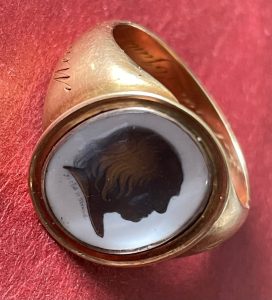A Special Commission for John Field
It was not uncommon for well-to-do Georgian gentlemen to allocate a sum of money in their will for the purchase of mourning attire and rings for close friends and family. Typically these rings would be gold and black enamel bands personalised with the deceased’s name in gold lettering.
But when the philosopher and social reformer Jeremy Bentham died in 1832 at the age of 84, he not only left precise instructions in his will for the scientific use and future display of his body but he also bequeathed 26 mourning rings to named individuals including his publisher, his dentist, his lawyer, his secretary, his niece and his servant boy. The creation of these rings was entrusted to John Field, a leading silhouette artist with a studio on the Strand.

John Field was well-established as an artist having worked alongside John Miers for over thirty years until the latter’s death in 1821. One of his specialisms was painting small finely gilded silhouettes on ivory to be mounted in jewellery settings such as rings, lockets or frill pins. Field was therefore a natural choice to fulfill Bentham’s lucrative commission.
It would appear that the order for the rings was agreed in 1822, a decade prior to Bentham’s death, as a note records Bentham’s secretary delivering locks of his employer’s hair to Field’s studio in November of that year. Bentham probably sat for and approved his profile at this time so Field would have the image ready to copy when the time came to produce the rings.

That time came in 1832 following Bentham’s death in June of that year. This is evidenced by Field’s signature on the ring profiles – ‘Field 11 Strand’. John Field did not move his studio to 11 Strand until 1830 and by late 1832 he had moved on to 2 Strand. By this time he was working in partnership with his son, Henry William.
Sadly the building at no. 11 Strand no longer retains any trace of its Georgian facade.

Born in 1810, Henry William Field was John’s youngest child. He inherited his father’s artistic ability and exhibited at the Royal Academy from an early age. His particular skill though was in metal and jewellery work as shown in his advertisement –
Miniature Frames and Cases of every Description manufactured by H.W. Field, also jewellery and seal engraving.
It can be deduced therefore that William Henry Field was responsible for crafting the gold settings for the Bentham memorial rings and for personalising them with the recipient’s details. Each ring has on the underside a lock of Bentham’s hair within an aperture around which is engraved ‘Jeremy Bentham’s Hair & Profile’ with the addition of his dates around the inside of the shank – ‘born 4/15 Feb. 1747 & died 6 June 1832 in his 85 Yr’. (The dual dating accommodates the transition from the old style Julian Calendar to the new style Gregorian Calendar adopted in England in 1752.) Each ring was then presumably sized by William Henry and personalised with the name of the recipient engraved around the outside edge of the shank, the example illustrated below being engraved ‘Memento for Henry Bickersteth Esq.’

Of the 26 rings that were made and distributed, the current whereabouts of only seven rings has so far been traced so the search continues . . .